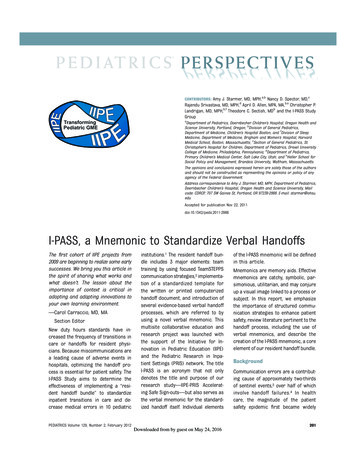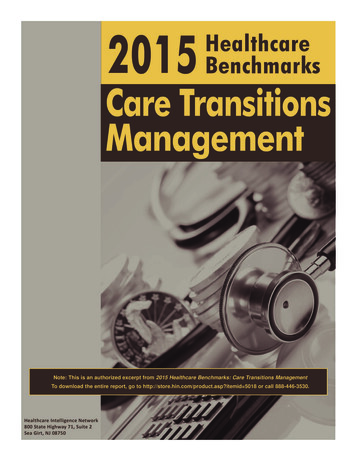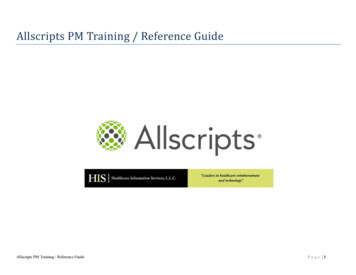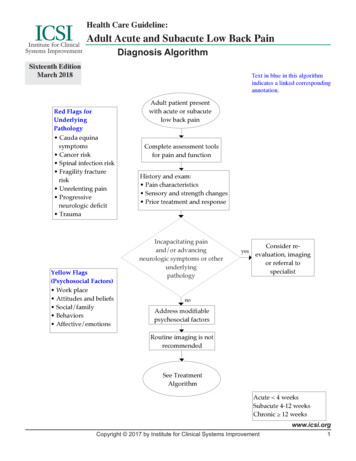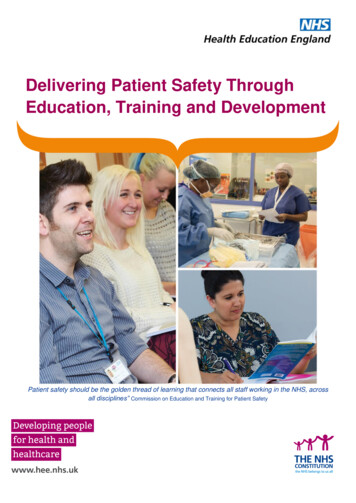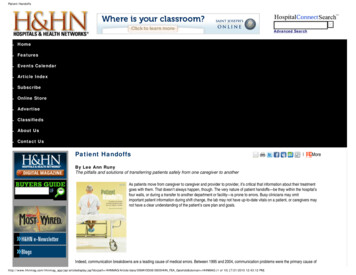
Transcription
Patient HandoffsGOAdvanced Search Home Features Events Calendar Article Index Subscribe Online Store Advertise Classifieds About Us Contact UsPatient Handoffs MoreBy Lee Ann RunyThe pitfalls and solutions of transferring patients safely from one caregiver to anotherAs patients move from caregiver to caregiver and provider to provider, it’s critical that information about their treatmentgoes with them. That doesn’t always happen, though. The very nature of patient handoffs—be they within the hospital’sfour walls, or during a transfer to another department or facility—is prone to errors. Busy clinicians may omitimportant patient information during shift change, the lab may not have up-to-date vitals on a patient, or caregivers maynot have a clear understanding of the patient’s care plan and goals.Indeed, communication breakdowns are a leading cause of medical errors. Between 1995 and 2004, communication problems were the primary cause ofhttp://www.hhnmag.com/hhnmag app/jsp/articledisplay.jsp?dcrpath HHNMAG/Article/data/05MAY2008/0805HHN FEA Gatefold&domain HHNMAG (1 of 10) [7/21/2010 12:43:12 PM]
Patient Handoffs65 percent of sentinel events, according to the Joint Commission. In 2005, a Joint Commission analysis found that 70 percent of sentinel events werecaused by communication breakdowns, half of those occured during handoffs. To address the problem, the Joint Commission instituted a NationalPatient Safety Goal in 2006 calling on hospitals to implement a standardized approach to patient handoffs.Finding solutions, however, isn’t easy. There’s a dearth of research regarding handoffs, says Richard Frankel, senior research scientist at the VAHealth Services Research and Development Center of Excellence on Implementing Evidence-Based Practice at the Richard L. Roudebush VAMedical Center, Indianapolis. Many health care organizations are turning to the aviation and nuclear power industries for guidance. Salem (Ore.) Hospital,for example, adopted Crew Resource Management techniques originally developed by NASA and used throughout the airline industry. CRMinstills standardization into all aspects of care delivery. “We had a number of events and near-misses in which communication was the root cause,”says Laurie McKeown, M.D. Huddles are now standard during shift change, and forms and checklists help ensure the consistent transfer of information.The key is to implement processes that clearly define the transfer of responsibility from one caregiver to another, standardize the communication processand allow for an interactive exchange between the parties involved. Frankel notes, “A lot of focus has been placed on the communication aspect andless focus on the relationship aspect of handoffs.” To be effective, caregivers need to have a working relationship that is built on trust with theindividuals involved in the transfer.Health care organizations need to examine their current practices to identify barriers to the handoff process for transitions within and outside the hospital.For example, is the medication reconciliation process thorough? Are the discharge summaries timely? Has the hospital team spoken with the skillednursing facility? “There’s no one-size-fits-all process,” says Cheri Lattimer, R.N., executive director of the Case Management Society of America. “Theonly common denominator is the patient.” To improve handoffs, patients should be involved whenever possible because they can be strong advocates inthe care process.This gatefold examines patient handoffs and provides some tools and techniques hospitals are using to improve the process within their organizations.What is a Handoff?Handoffs occur anytime there is a transfer of responsibility for a patient from one caregiver to another. The goal of the handoff is to provide timely,accurate information about a patient’s care plan, treatment, current condition and any recent or anticipated changes.Tools and Techniques to Assist in HandoffsVarious tools and techniques can help streamline the handoff process and establish standardized communications. Organizations should considerusing structured tools––such as mnemonics, templates or checklists––to ensure that information is not lost during the handoff. These techniques canalso ensure the timely, accurate exchange of information. Below is a look at some common techniques. Hospitals may adopt or adapt these techniquesas best fits their organization’s culture and needs. These techniques can also be used in combination.AUDIOTAPESAudiotapes are a common means of sharing information during handoffs. They provide a fast, effective means of communication and can be bolstered bythe use of a predetermined checklist. Audiotapes allow the outgoing clinician to provide a detailed assessment to the oncoming clinician. Usedalone, audiotapes do not meet the Joint Commission National Patient Safety Goal. There needs to be an opportunity for those involved in the handoff toask and answer questions. Ideally, the outgoing caregiver would remain on-site during review of the audiotape allowing face-to-face discussion.FORMS and CHECKLISTSForms and checklists allow a quick, consistent exchange of information. Information technology systems, such as electronic medical records, can enhancethe process. Forms and checklists can be placed in the patient record. Paper forms can be physically passed from one caregiver to another. Whenelectronic forms are used, it’s important to ensure that the information is received and reviewed. Again, it’s important to allow caregivers to ask and respondto questions.http://www.hhnmag.com/hhnmag app/jsp/articledisplay.jsp?dcrpath HHNMAG/Article/data/05MAY2008/0805HHN FEA Gatefold&domain HHNMAG (2 of 10) [7/21/2010 12:43:12 PM]
Patient HandoffsThe FIVE-PsThe Five-Ps were developed by Sentara Health Care in Norfolk, Va., to streamline the transfer of responsibility among caregivers and patient information.The Five-PsPatientName, identifiers, age, sex, locationPlanPatient diagnosis, treatment plan, next stepsPurposeProvide a rationale for the care planProblemsExplain what’s different or unusual about this specific patientPrecautionsExplain what’s expected to be different or usual about the patientSources: H&HN research and Sentara Health Care, 2008I PASS the BATONThis technique is recommended by the Department of Defense’s Patient Safety Program to provide an optimal structure to improve communicationduring transitions in care. It should include opportunities to confirm receipt, ask questions, clarify information and verify that the information is understood.This technique is designed to assist with both simple and complex handoffs.IIntroductionIndividuals involved in the handoff identify themselves, their roles and jobsPPatientName, identifiers, age, sex, locationAAssessmentPresent chief complaint, vital signs, symptoms and diagnosisSSituationCurrent status and circumstances, including code status, level of certainty oruncertainty, recent changes and response to treatmentSSafety ConcernsCritical lab values and reports, socioeconomic factors, allergies and alerts, such as riskfor fallsBBackgroundComorbidities, previous episodes, current medications and family historyAActionsDetail what actions were taken or are required and provide a brief rationale for thoseactionsthehttp://www.hhnmag.com/hhnmag app/jsp/articledisplay.jsp?dcrpath HHNMAG/Article/data/05MAY2008/0805HHN FEA Gatefold&domain HHNMAG (3 of 10) [7/21/2010 12:43:12 PM]
Patient HandoffsTTimingLevel of urgency and explicit timing, prioritization of actionsOOwnershipWho is responsible (nurse/doctor/team), including patient and family responsibilities?NNextWhat will happen next? Any anticipated changes? What is the plan? Any contingencyplans?Source: Department of Defense Patient Safety Program, “Healthcare Communications Toolkit to Improve Transitions in Care,” 2008SBAR 2: An adaptation to the popular techniqueSBAR is a communications technique that is modeled after a process used on nuclear submarines. It facilitates the consistent, concise exchangeof information. Hospitals are adopting SBAR to improve communication exchanges among clinicians. It is also being adopted to standardize the exchangeof information during the handoff process. SBAR is suitable for simple handoffs; some industry experts feel SBAR does not delve deeply enough into thelevel of information needed during a complex handoff. “SBAR is a good model, but it’s incomplete,” says Steve Harden, president of LifeWingsPartners, Memphis, a health care consulting firm that specializes in adapting the Crew Resource Management technique to the health caresetting. “Organizations need to be specific about what each letter means.” He suggests adding two letters to the mnemonic to make thecommunication exchange more thorough.I IntroductionIndividuals involved in the handoff identify themselves, their roles and jobsS SituationComplaint, diagnosis, treatment plan and patient’s wants and needsB BackgroundVital signs, mental and code status, list of medications and lab resultsA AssessmentCurrent provider’s assessment of the situationR RecommendationIdentify pending lab results and what needs to be done over the next few hours andother recommendations for careQ Question and Answer An opportunity for questions and answers is built into the handoff processSource: H&HN research, 2008Joint Commission RequirementsThe 2006 Joint Commission National Patient Safety Goals included a requirement that hospitals implement a standardized approach tohandoff communications, including an opportunity for individuals involved in the process to ask and respond to questions. The goal does not dictatehow organizations should do this; each organization must develop its own method.The goal is meant to be flexible, recognizing there’s a need for variation within organizations. For example, the type of information vital to patient handofffrom the OR to PACU differs from the type of information needed for transfer from the ED to a cath lab. And the handoff during nursing shift changewould likely differ from the handoff of a patient from one physician to another.To meet the Joint Commission requirement, organizations must define, communicate to staff and implement a process that results in theconsistent communication of patient information. According to the Joint Commission, standardization provides an opportunity to educate staff aboutthe process and helps support the consistent implementation and use across the organization. Again, the process may vary slightly from departmenthttp://www.hhnmag.com/hhnmag app/jsp/articledisplay.jsp?dcrpath HHNMAG/Article/data/05MAY2008/0805HHN FEA Gatefold&domain HHNMAG (4 of 10) [7/21/2010 12:43:12 PM]
Patient Handoffsto department, but the basic premise is the same. It’s important to include a step to review the effectiveness of the processes once they are in placeand address any problems that are identified.The Joint Commission provides details as to what a standardized approach should include: The handoff situationWho is, or should be, involved in the handoff communicationOpportunities for individuals involved in handoffs to ask and respond to questionsAn outline for when to use certain communication techniques, such as repeat-back or read-back or the R) techniqueWhat print or electronic information should be available during the handoffSource: The Joint Commission, 2008The U.S Department of Defense Handoff ModelThe triangle is designed to help providers understand where communication gaps occur. Not all of the data elements apply to all types of handoffs; thetriangle represents the elements required for a complex patient handoff.Urgency Emergency TreatmentQuestions to Ask SAFETY CONCERNS TIME CRITICAL ACTIONSMAJORCONSID ANTICIPATION: NEXT STEPS WHO IS RESPONSIBLE?Identify safety concerns (e.g., mentalconfusion, allergic reactions, fall risk, andspecific error risk based on circumstances, siteor procedure verification)Identify time critical actions (e.g., give IVantibiotics within 4 hours, to operating roomwithin 4-6 hours, and IV medications neededSTAT.)What comes next and what is expected? Whatpotential changes to watch for? What are thenext steps (e.g., surgery, biopsy,chemotherapy)?Identify who is responsible for the patient’scare. Establish who to call for appropriateinformation. Who is the primary care provider?What are the patient and g app/jsp/articledisplay.jsp?dcrpath HHNMAG/Article/data/05MAY2008/0805HHN FEA Gatefold&domain HHNMAG (5 of 10) [7/21/2010 12:43:12 PM]
Patient HandoffsERATIONS PATIENT/FAMILY AWARENESS MEDICATION RECONCILIATION GENERAL CARE PLAN CIRCUMSTANCES/STATUS EVALUATEUNCERTAINTIES CRITICAL VALUES & INFOIs the patient and family aware of informationneeded for informed decision-making? Arethey aware of the care plan and available toparticipate in the plan? Do they understand allof the responsibilities for monitoring anongoing care plan?Accurate and updated information includinglists and doses is avialable to the patient andcare providers. This is the opportunity for acomprehensive medication review and to makecorrections or clarifications as needed.The general care plan is established and allrelated protocols and critical pathwaysdetermined. State it briefly but concisely. Ifneeded, develop a disease management plan.Establish the patient’s current circumstances.What is the patient’s status and medicalcondition? What is their resuscitation-codestatus?What is the level of confidence about currentcondition and remaining uncertainties? Whatinformation is still pending, such as lab orimaging results? What consultations are stillpending? Clarify ”what we don’t know yet.”Establish critical values or information (e.g.,serum potassium of 2.4), critical clotting studyresults, recent imaging or biopsy resultssuggesting or confirming the presence of amajor disease (e.g., can
The goal of the handoff is to provide timely, accurate information about a patient’s care plan, treatment, current condition and any recent or anticipated changes. Tools and Techniques to Assist in Handoffs Various tools and techniques can help streamline the handoff process and establish standardized communications. Organizations should consider
